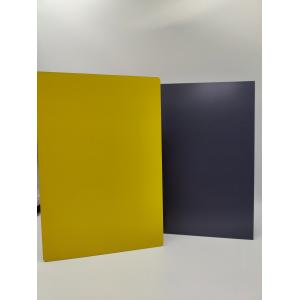

Add to Cart
Fire Rated ACP Sheets - 6.0mm, Stone Grain, Signboards, Aluminum Composite Panel
DESCRIPTION
Regarded as aluminum composite panels, these are composite materials composed of two aluminum cover sheets and a non-aluminum core. The inherent properties of these panels, such as high rigidity, low weight, and resistance to weather, have rendered them a popular choice in sectors like architecture and signage. They can be manipulated into various forms and sizes, thereby enabling a high degree of design flexibility. In addition, aluminum plastic panels exhibit good thermal insulation and soundproofing qualities, hence their use in insulating building envelopes and noise barrier walls.
Company Profile
Commencing in 1999, we've assimilated the finest extrusion tools and techniques. Harnessing years of innovation, our formidable team specializes in Aluminum Composite Panels, utilized across varied spaces. Our robust quality ethos ensures products that captivate, making them a decor trendsetter. With an eye on global standards, our certifications, like ISO 9001:2008, are a testimony. Collaborating with research agencies and industry groups, we’re thankful for the enduring support. Represented by “Richly Bound”, we fashion a spectrum of decorative solutions. Leading the market, our offerings are celebrated across regions. Proximate to major hubs, we're enthusiastic about global alliances.
Product Features
1. Uniquely Lightweight: Holds an excellent strength-to-weight ratio. With uniform
stiffness (E.j), the weight per unit surface area of these aluminum
composite panels is about 60% of aluminum panels, and only 30% of
steel panels.
2. Incredible Adhesive Strength: Features high 180° peeling strength. There's no spontaneous
peeling between the aluminum sheet and the plastic core material,
even after lengthy use.
3.Weather Tolerance: Exhibits virtually no change in color or gloss with long-term
outdoor use, with the coating remaining intact, and the typical
lifespan is over twenty years.
4.Anti-Corrosive Properties: The surface coating maintains strong adhesion and can withstand
the corrosion of acid (10%H2S04), alkali (10%NaOH), and salt mist;
the strength of the PVDF fluorocarbon resin coating is notably
superior.
5.Wind Load Resistance: Meets national A-grade criteria, satisfying wind load resistance
demands for high-rise building exterior decoration.
6.Fire Resistant: The middle layer is composed of non-toxic polyethylene, encased by
non-combustible thin aluminum sheets on both sides.
Application fields
1.Structural Outdoors: Exterior solutions for tall buildings, standalone residences,
organizational headquarters, and commercial edifices.
2.Space Decor: Augmenting living, working, and business spaces with wall
applications, overhead themes, and room dividers.
3.Public Notices: Constructing outdoor ads, retail banners, navigational posts,
graphic ads, and platform exhibits.
4.Movement Sector: Structural components for public buses, locomotives, subway rides,
flying machines.
5.Decorative Joinery: In fashioning trendy furniture, clothing storage, culinary units,
and other interior attachments.
6.Industrial Surroundings: Practical in engineering settings, safeguarding apparatus, and
sanitized surroundings.
7.Consumer Spaces: Planning commercial spaces, transaction booths, and showcasing
units.
8.Guest Services: Infrastructural designs in resting places, vacation spots, and
culinary establishments.
9.Wellness Buildings: Facade applications in therapeutic centers, care establishments,
due to its antiseptic and enduring nature.
10.Pedagogical Sites: Campus settings, academic centers, employing it for communication
tools, seating, and space segmentation.
11.Activity Zones: Infrastructural needs in match venues, wellness areas, and
recreational centers.
12.Connectivity Centers: External and informational applications in air junctions, rail
hubs, mass transit locales, and shipping points.
Product processing performance
Our range of aluminum composite panels can be adeptly modified with general carpentry and metallurgy equipment. Techniques such as lacerating, bisecting, etching, punching, condensing, pleating, and recurving are manageable. These ensure finesse in executing structural aesthetic mandates, notably patterns like helicals, anti-helicals, micro-angled terminuses, and varying vertexes. This pliability is rare in other decorative elements.
1.Partitioning: Equipments like manual blades, electric slicers, and loop cutters
are proficient.
2.Etch Milling: When maneuvered with a handheld etcher, a myriad of geometric
shapes can be hand-carved.
3.Apex Clipping: Through punch-tools and apex clippers, uniting in a structure is
streamlined.
4.Amalgamating: A blend using warm air instruments and resin welding threads is
possible.
5.Apex Curve: Successive to etch milling, it's feasible to mold multiple angles.
6.Spiraling: Trio-point or triple-roll devices are proficient for such tasks.
7.Stenciling: Imprint via stencil imprint methods.
8.Mounting: Engage mechanisms like bolts, pins, and self-piercing screws.
9.Stamping: Depressions are possible using an expansive puncher.
